https://tech.sina.com.cn/scientist/2019-07-10/doc-ihytcerm2644009.shtml
中国2020年首探火星!星辰大海才是我们的征途!
2019年07月10日 14:01 科学大家
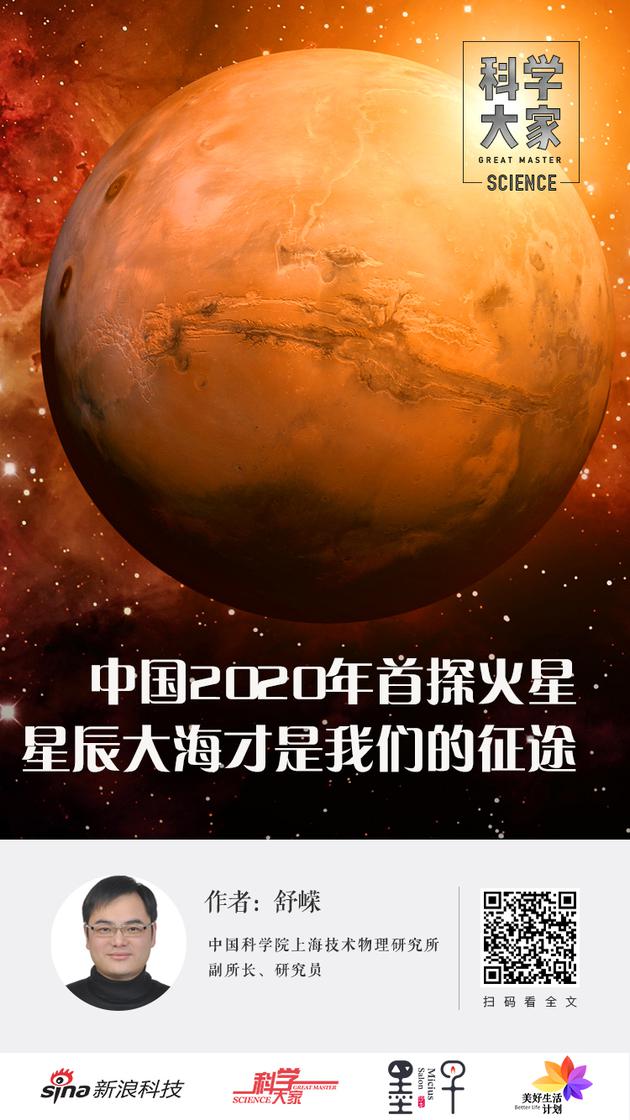
出品| 新浪科技《科学大家》、墨子沙龙
撰文| 舒嵘 中国科学院上海技术物理研究所副所长、研究员
科学家眼中的火星
火星是太阳系八大行星中第四颗,是一颗类地行星。古时候,中国人一直称火星为荧惑星,意味着莹莹火光,离离乱惑之意。在西方一直用古希腊神话传说中英雄名字命名火星。真实的火星是什么样子的呢,在人造卫星上看,火星上面既有像沙漠、像流过河流的戈壁滩,也有山丘等地貌。火星上的河流是没有液态水的,但是在火星南北极下面有大量冰川地下水。
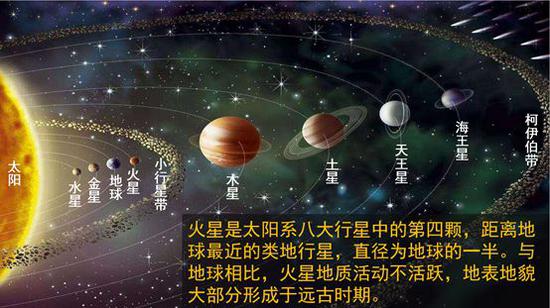
火星的地质情况跟月球是非常接近的。火星的大小介于地球和月球之间,重量大约是地球的十分之一,体积相当于地球的六分之一。在火星上一年大约相当于地球上两年。
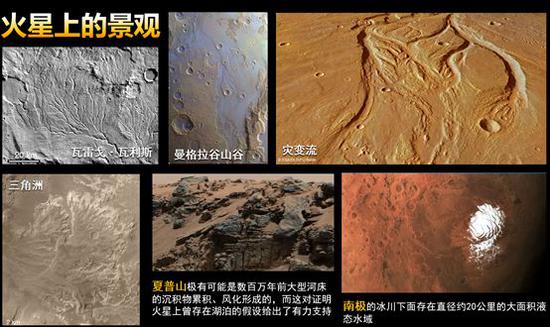
我们都非常想知道地球的过去与未来。有一门学科叫比较行星学,通过比较八大行星中其他行星演变的情况来看地球的过去跟未来。在约45亿年前,宇宙形成的初期,火星和地球是一样的,它的表面也是有流水,到了30亿年前左右,地球上出现了光合作用,产生了生命。火星到后面水消失了,变成了一个又冷又干的星球。所以探索火星的气候变化以及地质的演化,对于保护地球,拓展我们人类生存的疆域,有非常重要的意义。火星是我们整个深空探测领域,除月球以外的第二个重要研究的星球。
科学家想要看火星的什么?要从三个方面看:生命、气候、地质。
我们先要知道,在火星上面是否有过生命的出现,有没有生命的一些痕迹。第二个方面,因为火星上是有大气的,了解火星气候演变的过程以及历史很有意义。另外是研究火星表面和地质演化的过程,可以更好地帮助理解地球的早期演化历史和生命的起源。
火星探险
整个深空探测都是在科学目标牵引下,实现探索与技术相结合。
记得当时做嫦娥项目的时候,欧阳自远院士说过一句话,如果科学家把探索的目标想清楚了,在技术的支撑下,才能实现这些科学的梦想。实际上国际上的科学界,对宇宙的探索也是走的这样一条路。
火星探测风险是很大的,我国2020年要发射一颗火星探测器。但实际上在2011年,我们跟随俄罗斯的福布斯-土壤探测器已经搭载过一颗火星探测器,这颗火星探测器是由上海航天八院研制的,很不幸这个发射器升空以后,由于俄罗斯人过早的把计算机系统转入自动的导航模式,结果由于里面的软件有点bug,导致探测器没有脱离地球轨道,变成了地球上的一颗卫星,而且轨道不高,所以抢救了几个月以后,这颗卫星最后坠入大气层就毁掉了。从整个世界来说,火星探测的成功概率不到50%。
2020年中国第一次用全新研制的长征五号火箭,要一次实现绕、落、巡这三个目标,难度非常大。美国的海盗1号和海盗2号,在1976年第一次成功进入火星轨道,降落到火星上去。目前火星探测以美国为主,然后是欧盟ESA、日本,我们也期盼着,2020年以后中国的火星探测越来越多。
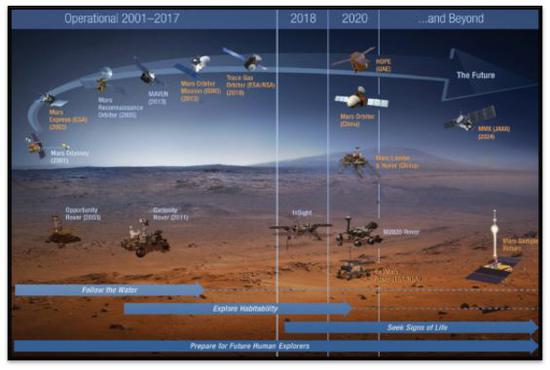
从上面的图中可以看到,围绕着水的寻找,人类从环绕器的三个探测器加上“机遇号”火星车,开展了很多研究工作。围绕着可居住性发射了轨道探测器、微量气体探测器以及“好奇号”火星车,进行了各种探测活动。最近一次人类成功在火星上降落的是“洞察号”火星着陆器,它是研究磁场和大气是怎样的情况、多久消失的,另外还要进行类地行星的研究。
无论是NASA、ESA还是中国,着陆器或者火星车,其实都是要研究可居住性和生命的痕迹。目前已经做了寻找水的探险,水是肯定有的,但是水不在表面,在火星表面的下层,这点在目前科学研究成果中是百分之百确定的,因为在火星上既发现了水流的痕迹,还测到氢的元素。第二个是可居住性,火星上二氧化碳、水这两个元素比月球环境要好很多。第三个方面,火星过去到底有没有生命存在,这个研究做的比较少。
探索火星的挑战
我们要去火星的探险和月球的探险有很大的区别。
第一个,火星距离很远,最远超过4亿公里,近的时候约是5500万公里,一般选择在大约8000万公里的距离发射探测器。第二个是温度,到了晚上会非常冷,达到零下143摄氏度,白天最热的地方在赤道附近,也就是35摄氏度左右。另外大气非常稀薄,而且还有沙尘暴。
围绕这三个特点,工程师怎么解决呢?
不是每时每刻飞去火星都是适合的,因为我们要找一个距离合适的时间,每隔26个月有一个火星发射窗口。我们国家本来在2018年准备发射一个火星探测器的,但是由于种种原因没有搞成,后来就拖到2020年。2020年的夏天,无论是欧洲、美国还是中国,都将往火星发射自己的探测器。飞到火星要花7个月的时间,从地球去月球只需要9天。在火星上要10多分钟才能把一个信号传输回来,而且信号传输的速率是很低的,我们已经用上了5G,速率非常高,但是火星到地球也就是百k量级的比特,低传输效率限制了科学的探索。
落到火星上以后面临三个挑战。
第一是沙尘暴,沙尘暴来了以后,火星车必须要把自己保护好,否则整个仪器会被掩盖掉。而且沙尘暴来了以后,太阳能帆板上面的沙尘会降低能源的转化效率。
第二是光照问题,因为火星离太阳很远,在火星上接收到的太阳光能量只有月球表面的40%。我们国家的月球车是两块帆板,但是我们的火星车要由四块帆板构成的,这样才能能量保持大致相当。
第三是火星上的重力,月球的重力只有地球的六分之一,但是火星重力没有那么小,在火星上面要跑同样重量的火星车,需要的能量也比月球上要高。这三个问题给火星车的应用带来了一些新的问题。
我们要去火星上的一个地方,首先要去选择着陆点,这是非常重要的,先从工程上来说,既不能是孤岛,又不能是陡坡,还不能是非常软的地方,不能让火星车下去就无出路、倾倒、或陷进去;另外,因为火星上有高山、峡谷,不能进去以后把太阳挡住了,没有光照就没有能源;而且还要考虑到通讯,从科学家的角度,非常希望去的位置有很好的科学研究价值。
下图是美国NASA七次火星探测的着陆点,大家可以看到2020年中国预定着陆区是在这两个地方(红色标记),为什么要选两个预定着陆区?因为火星上有不确定的大气流和风暴,我们要根据实际情况来进行降落。左边的降落区的好处是我们会跟美国NASA的着陆点比较接近,大家都会在一块大的区域来共同对火星表面进行探索和研究,科学数据可以进行国际化的共享。
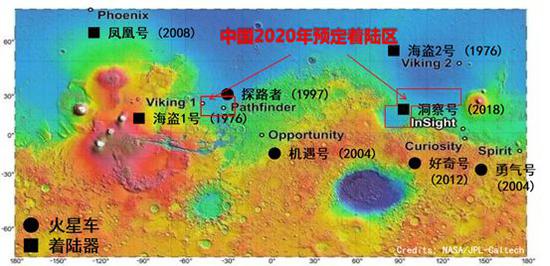 中国2020年预定着陆区
中国2020年预定着陆区
着陆过程是最惊心动魄的。我们中国月球探测30分钟叫“黑色30分钟”,在火星上有“恐怖7分钟”,目前在国际上有三种降落方式,一个叫气囊式,“勇气号”、“机遇号”都采取了这种方式——一个气囊下来以后弹跳,最后用不倒翁的原理打开,保证火星车从里面出来。第二种方式是支架式,相当于有四条腿,像一张桌子一个板凳一样下去,当然先是降落伞,因为有大气所以都要用降落伞,区别在于靠近火星表面的时候。第三种是起重机天抓式,由于火星表面的各种坑、石头特别多,支架式落在石头上会翻身,那车就要翻掉了,所以采取了一种像直升机一样,可以把火星车放下来,上面的着陆器平移,来找一块相对平坦的区域。
 气囊式着陆
气囊式着陆
我们国家的方案是什么?由于我们必须自力更生,所以我们也进行了创造。
我们把支架式和起重机天抓式相结合。我们的着陆器也是有四条腿,也有降落伞,但是我们四条腿的着陆器自身具有避障的模式,可以自主避障平移。这项技术是在探月工程里面来做的,探月工程着陆器在100米悬停的时候,在50×50米的区域,可以在250毫秒内对月表区域进行三维拍照,然后找一个平坦的区域平移降落下去。嫦娥四号能够成功的落在月球的背后,月球背后的情况我们事先并不知道,因为月球背后陨石撞击坑非常多,由于有了这项技术,地形不管多么复杂,都可以进行自主避障。2020年中国火星探测计划,用了嫦娥奔月的技术,再加上载人航天返回大气层的降落伞减速两项技术的结合。
火星表面的元素探测
NASA“好奇号”上面搭载了α粒子X-射线光谱议,用激光枪击打物体的表面,做岩石矿物质成分的测量,主要来确定是否有水,是否有适合于生命存在的环境。中国的“玉兔一号”月球车跑了没多少米,“玉兔二号”到目前就跑了100多米。在火星上跑的时间最长的火星车已经有六年了,就是NASA “机遇号”火星车,它跑了45公里,在遭遇一次巨大的沙尘暴以后,最后宣布它的任务终结。
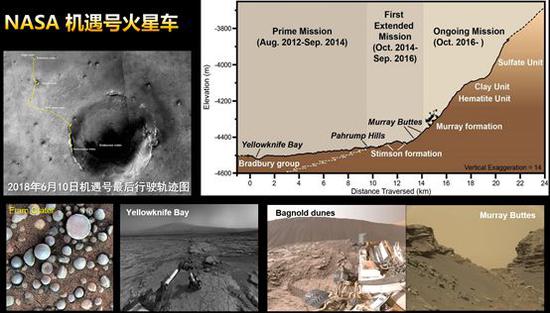 NASA机遇号火星车
NASA机遇号火星车
我们国家的着陆器上面搭载了很多设备,一共有30公斤的有效载荷。我们课题组研究的是物质成分探测仪,在上面占了16公斤,个头非常大。其他的还有导航相机,气象站等一些测量设备。
物质成分探测仪是用来做什么的?它是用激光聚焦石头局部,气化产生等离子体(等离子体是原子里的外层原子摆脱原子核束缚成为自由电子,是一个电离的过程),等离子体在冷却过程中会辐射出原子光谱,原子光谱代表这个元素的“指纹”。只要能测到等离子体冷却过程中产生的光谱曲线的位置,就能知道它代表什么元素,信号的强度能够反映元素的含量。这就是激光诱导等离子体光谱技术。元素周期表里面绝大部分元素都能测,一次激发就能同时探测多种元素。
除了用激光激发物体元素以外,还有被动的短波红外光谱测量。被动的短波红外光谱测量通过光谱分析进行分子层面的测量,可以测化合物的成分。
这个仪器上面有一个二维指向镜,可以摇头摆尾到处看。我们的月球车上面的光谱仪装在车上动不了,最后是车到哪里只能看哪里,玉兔一号的车轮子坏了停在那里,最后只能永远看一个地方。我们在火星车上面弄一个可以动的镜子,这样哪怕火星车不动了,还可以到处看。这个黑色的里面是一个望远镜系统,里面还有激光器,最后有个定标板。跟美国相比我们少了一个拉曼测量的功能。
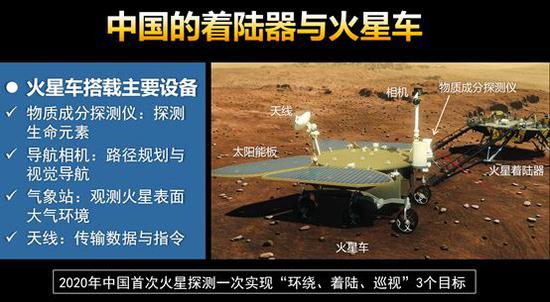 中国的着陆器与火星车
中国的着陆器与火星车
火星探测是由环绕器与火星车相结合,我们要进行星地的联动探测。也就是说在环绕器上还要再装一个光谱议,和火星车上的主被动结合,两个进行比对测量。在环绕器上装了一个火星矿物光谱分析仪,是一台推帚式的分子光谱探测设备。这个光谱探测设备能够提供多个波段的光谱信息,还有一个图像信息。
光谱测量能发现什么?我们以嫦娥四号为例说明。假如说月球是个白煮蛋的话,蛋白里到底装了什么?实际上大型的固态天体都存在这样的问题。科学家假设月幔和地幔是一样的,那么里面应该有橄榄石存在。嫦娥四号的着陆点非常巧,首先我们选择了一个艾特肯盆地,这是最古老的撞击盆地之一,同时落的那个地方冯·卡门撞击坑是个二次撞击坑,所以它有机会通过陨石的撞击,把月幔里深层的物质抛射到月球的表面。也非常巧,玉兔二号正好降落到了这个区域,通过对两个探测点土壤的光谱探测,获得的数据显示嫦娥四号着陆区的月壤物质中,橄榄石相对含量是最高的,低钙辉石次之。我们在实际数据采集上面第一次证明了科学家的预测,有新闻称中国发现了美国阿波罗计划都没有发现的一个新的科学发现。
我国的深空探测
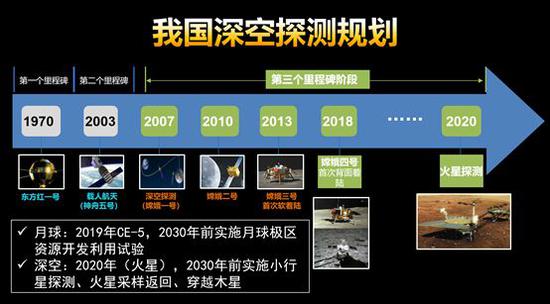 我国深空探测规划
我国深空探测规划
我国在2020年前已经通过嫦娥一号到嫦娥四号以及今年的嫦娥五号的发射,将实现对月球的“绕”、“落”、“回”第一个三部曲。在2020年以后2030年前,我们国家将要进行月球南极极区资源的开发利用。上个月特朗普给美国NASA增加16亿重返月球的经费需求,在2024年前美国要重返月球,要把第一个女宇航员送到月球,送到月球的南极极区。
为什么要去极区?在月球的极区,由于是永久阴影区,外来陨石带来的水都储存在那里,没有挥发掉,是固态水,所以大家都想到极区建一个永久的实验站,在那里能够支持我们的基本物质需求。我们国家在2030年前要实施月球极区资源开发利用实验,中间要有好几个实验,我们要去探测月球南极,然后再降到月球南极,再把无人的装备装上去,在2030年之前主要还是进行无人的科学考察,但是在后期会考虑有人的实验。
第二条线就是在深空探测这条线,我们不能只关心月球,月球离地球太近了,火星是最适合改造成人类居住的星球,所以我们在2030年前还有两次火星的探测任务,还要把火星的样本从火星带回地球。还有一个就是小行星,小行星带是阻碍地球冲出太阳系的障碍,但是小行星带富含资源。打个比方,铂金是非常贵重的,但是科学家经过远距离天文观测,认定有个别小行星全是铂金,如果全是铂金的小行星被拖回地球的话,可能咱们的戒指都不值钱了,而且有的小行星还富含水,所以小行星探测、采样是目前深空探测的热点,日本在这方面做的比较好。我们国家在2030年前应该有一次小行星的探测计划。
另外我们有个梦想,就是要飞出太阳系,我们要进行一次木星穿越。《流浪地球》里面把木星炸了,我们在炸之前先要看一看,然后穿越木星,看看太阳系的边缘。这个是我们国家在2030年前的三个重要的深空探测计划。
我们中国人在航天技术方面,是个后起者,东方红一号,1970年发射到现在短短的50多年。但是近些年随着深空探测整个计划的发展,我们中国人走向宇宙的号角也越来越响了。
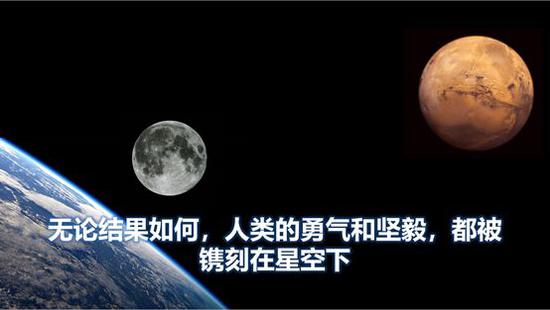
我想人类探索未知的愿望,有非常大的激情。宇宙到底是怎么起源,怎么消亡的,我想无论结果如何,人类的勇气和坚毅都将被镌刻在星空下。
推荐
《科学大家》栏目精彩文章汇总
《科学大家》专栏投稿邮箱:[email protected] 来稿请注明姓名、单位、职务


关键词 : 火星宇宙探测器科学大家
China is the first to explore Mars in 2020! The sea of stars is our journey!
July 10, 2019 14:01 Science everyone
Produced | Sina Technology "Scientific Everyone", Mozi Salon
Author | Shu Wei Deputy Director and Researcher, Shanghai Institute of Technical Physics, Chinese Academy of Sciences
Mars in the eyes of scientists
Mars is the fourth of the eight planets in the solar system and is a terrestrial planet. In ancient times, the Chinese have always called Mars a illusionary star, which means that Yingying is shining and away from chaos. In the West, Mars has been named after the heroes of ancient Greek mythology. What does the real Mars look like? On the satellite, Mars has landforms like deserts, Gobi deserts that flow through rivers, and hills. The rivers on Mars are free of liquid water, but there is a large amount of glacial groundwater beneath the north and south poles of Mars.
The geological conditions of Mars are very close to the moon. The size of Mars is between the Earth and the Moon. It weighs about one-tenth of the Earth and is one-sixth the size of the Earth. On Mars, it is about two years on Earth.
We all want to know the past and future of the earth. There is a discipline called comparative planetary science that looks at the past and future of the Earth by comparing the evolution of other planets in the eight major planets. At about 4.5 billion years ago, at the beginning of the formation of the universe, Mars was the same as Earth. Its surface was also flowing. By the end of 3 billion years ago, photosynthesis appeared on the earth and life was born. Mars disappeared into the back water and turned into a cold and dry planet. Therefore, exploring the climate change of Mars and the evolution of geology is of great significance for protecting the earth and expanding the territory of our human existence. Mars is the planet of our entire deep space exploration field, the second important study beyond the moon.
What do scientists want to see about Mars? To look at three aspects: life, climate, geology.
We must first know if there is any life on Mars, and there are some traces of life. In the second aspect, because there is an atmosphere on Mars, it is meaningful to understand the process and history of the evolution of Mars. In addition, the process of studying the surface and geological evolution of Mars can better understand the early evolutionary history of the Earth and the origin of life.
Mars exploration
The entire deep space exploration is guided by scientific goals, and the combination of exploration and technology is realized.
I remember when I was doing the project, Ouyang Ziyuan said a sentence. If scientists think clearly about the goal of exploration, they can realize these scientific dreams under the support of technology. In fact, the international scientific community, the exploration of the universe is also a way to go.
The risk of Mars detection is very large. China will launch a Mars probe in 2020. But in fact, in 2011, we followed the Russian Forbes-Soil Detector and already carried a Mars probe. This Mars probe was developed by the Shanghai Aerospace Eighth Hospital. Unfortunately, this launcher was launched after the Russian People prematurely transferred the computer system to the automatic navigation mode. As a result, the software inside was a bit bug, causing the detector to not leave the earth orbit, become a satellite on the earth, and the track is not high, so several people were rescued. After the month, the satellite finally fell into the atmosphere and was destroyed. From the entire world, the probability of Mars detection is less than 50%.
For the first time in 2020, China’s newly developed Long March V rocket will have three goals: winding, falling and patrol. It is very difficult. The US Pirates 1 and Pirates 2 successfully entered Mars orbit for the first time in 1976 and landed on Mars. At present, Mars exploration is mainly in the United States, then EU ESA, Japan, and we are also looking forward to more and more Chinese Mars exploration after 2020.
As can be seen from the above figure, around the search for water, humans have carried out a lot of research work from the three detectors of the surround device plus the "Opportunity" Rover. Orbital detectors, trace gas detectors, and the "Curious" Mars rover were launched around habitability for various exploration activities. The most recent human success on Mars is the "Insight" Mars Lander, which studies how magnetic fields and the atmosphere are, how long it has disappeared, and the study of terrestrial planets.
Whether it is NASA, ESA or China, landers or rover cars are actually studying the traces of habitability and life. At present, there has been an exploration for finding water. Water is definitely there, but water is not on the surface, on the lower surface of the surface of Mars. This is 100% certain in the current scientific research results, because traces of water flow are found on Mars. The element of hydrogen was also measured. The second is habitability. The two elements of carbon dioxide and water on Mars are much better than the lunar environment. In the third aspect, there is no life in Mars in the past. This research has done less.
Explore the challenges of Mars
There is a big difference between our expedition to Mars and the exploration of the moon.
First, Mars is far away, far exceeding 400 million kilometers, and is about 55 million kilometers in the near future. It is generally chosen to launch detectors at a distance of about 80 million kilometers. The second is temperature. It will be very cold at night, reaching minus 143 degrees Celsius. The hottest place in the day is near the equator, which is about 35 degrees Celsius. In addition, the atmosphere is very thin, and there is also a dust storm.
How do engineers solve these three characteristics?
It's not a good idea to fly to Mars every moment, because we have to find a time to the right, there is a Mars launch window every 26 months. Our country was originally preparing to launch a Mars probe in 2018, but for various reasons it was not completed, and it was later delayed until 2020. In the summer of 2020, whether it is Europe, the United States or China, it will launch its own detectors to Mars. It takes 7 months to fly to Mars and only 9 days to go to Earth from Earth. It takes more than 10 minutes on Mars to transmit a signal back, and the rate of signal transmission is very low. We have used 5G, the rate is very high, but Mars to the earth is a bit of the hundred kilograms, low transmission. Efficiency limits the exploration of science.
After falling to Mars, it faces three challenges.
The first is a sandstorm. After the sandstorm comes, the rover must protect itself, otherwise the whole instrument will be covered up. And after the sandstorm comes, the dust on the solar panels will reduce the energy conversion efficiency.
The second is the problem of illumination, because Mars is far from the sun, and the sun's energy received on Mars is only 40% of the surface of the moon. The lunar rover in our country is two windsurfing boards, but our rover car is made up of four windsurfing boards so that the energy is roughly equal.
The third is the gravity on Mars. The gravity of the moon is only one-sixth of the Earth's, but the gravity of Mars is not so small. The Mars, which runs the same weight on Mars, needs more energy than the Moon. These three questions have brought some new problems to the application of the rover.
We have to go to a place on Mars. We must first choose the landing site. This is very important. From the engineering point of view, it can't be an island, it can't be a steep slope, it can't be a very soft place, we can't let the Mars car. There is no way out, dumping, or sinking in. If there are mountains and valleys on Mars, you can't get in and block the sun. There is no energy without light. Also, considering communication, from the perspective of scientists, I hope very much. The location has good scientific research value.
The picture below shows the landing point of NASA's seven Mars explorations. You can see that China's scheduled landing zone is in these two places (red mark) in 2020. Why choose two scheduled landing zones? Because there are uncertain large air currents and storms on Mars, we have to make landings based on actual conditions. The advantage of the landing zone on the left is that we will be closer to the landing point of NASA in the United States. Everyone will jointly explore and study the surface of Mars in a large area, and scientific data can be shared internationally.
China is scheduled to land in 2020, China is scheduled to land in 2020
The landing process is the most thrilling. We have a 30-minute lunar exploration in China for 30 minutes and a "horror 7 minutes" on Mars. There are currently three types of landings in the world. One is called the airbag type. The "Courage" and "Opportunity" have adopted this. One way - a balloon bounces after it comes down, and finally opens with the principle of a tumbler to ensure that the rover comes out from inside. The second way is the bracket type, which is equivalent to having four legs, like a table and a bench. Of course, it is a parachute. Because there is an atmosphere, it is necessary to use a parachute, the difference is when it is near the surface of Mars. The third type is the crane day catching type. Due to the various pits and stones on the surface of Mars, the brackets will fall over the stone and the car will turn over. Therefore, a helicopter like the one can take Mars. The car is lowered and the lander on the top is translated to find a relatively flat area.
Airbag landing balloon landing
What is the plan for our country? Since we have to be self-reliant, we have also created.
We combine the bracket type with the crane day grip. Our lander also has four legs and a parachute, but our four-legged lander has its own obstacle avoidance mode and can be autonomously obstacle-free. This technology is made in the lunar exploration project. When the lunar exploration project lander is hovering at 100 meters, in the 50×50 meter area, the moon surface area can be photographed in three dimensions within 250 milliseconds, and then one is found. The flat area pans down. The No. 4 can successfully land behind the moon. The situation behind the moon is not known in advance, because there are many meteorite impact pits behind the moon. Thanks to this technology, the terrain can be autonomously obstacle-free, no matter how complicated. In 2020, the Chinese Mars Exploration Program used a combination of the two technologies of the rushing moon, and the combination of the two technologies of landing parachute deceleration.
Elemental detection on the surface of Mars
The NASA "Curious" is equipped with an alpha particle X-ray spectrum. The surface of the object is shot with a laser gun to measure the mineral content of the rock. It is mainly used to determine whether there is water and whether there is an environment suitable for life. China’s “Yu Rabbit No. 1” lunar rover ran no more than a few meters, and “Yu Rabbit No. 2” ran for more than 100 meters. The longest Rover on Mars has been in existence for six years, the NASA Opportunity Rover, which ran for 45 kilometers and finally announced its mission after a huge sandstorm.
NASA Opportunity Rover NASA Opportunity Rover
Our country's lander is equipped with a lot of equipment, a total of 30 kilograms of payload. Our research group is studying the material composition detector, which accounts for 16 kilograms and has a very large size. Others include navigation cameras, weather stations and other measuring devices.
What is the substance composition detector used for? It uses a laser to focus the stone locally, and gasification produces a plasma (the plasma is the outer layer of atoms in the atom and gets rid of the nucleus to become a free electron, which is an ionization process). The plasma radiates the atomic spectrum during the cooling process. The spectrum represents the "fingerprint" of this element. As long as the position of the spectral curve generated during the plasma cooling process can be measured, it can be known what element it represents, and the intensity of the signal can reflect the content of the element. This is the laser induced plasma spectroscopy technique. Most of the elements in the periodic table can be measured, and multiple elements can be detected simultaneously in one excitation.
In addition to laser excitation of object elements, there are passive short-wave infrared spectroscopy measurements. Passive short-wave infrared spectroscopy measures molecular measurements at the molecular level by spectral analysis.
This instrument has a two-dimensional pointing mirror that can be used to shake the head and look around. The spectrometer on our lunar rover can't be moved in the car. Finally, the car can only see where it is. The wheel of the Yutu No. 1 is broken and stops there. In the end, it can only see one place forever. We have a movable mirror on the Mars, so that even if the Mars is not moving, you can look around. Inside this black is a telescope system with a laser inside and a calibration plate. We have one less Raman measurement than the US.
China's Lander and Rover China Lander and Mars Rover
Mars exploration is a combination of a surroundr and a rover, and we want to detect the linkage of the stars. That is to say, there is another spectral discussion on the surroundr, which is combined with the active and passive on the Mars, and the two are compared. A Mars mineral spectrum analyzer is installed on the surroundr, which is a push-type molecular spectrum detection device. This spectral detection device is capable of providing spectral information for multiple bands, as well as an image information.
What can be found in spectral measurements? Let us take the example of the 嫦娥4. If the moon is a boiled egg, what is in the protein? In fact, large solid solid objects have such problems. Scientists assume that the moon and the mantle are the same, then there should be olivine in it. The landing site of the No. 4 is very clever. First we chose an Aitken basin, which is one of the oldest impact basins. At the same time, the von Carmen crater is a secondary impact crater, so it has a chance to pass. The impact of the meteorite throws the deep material in the moon into the surface of the moon. It is also very coincident that Yutu No. 2 has just landed in this area. Through the spectral detection of the soils of the two detection points, the data obtained shows that the relative content of olivine is the highest in the lunar soil of the No. 4 landing area, low calcium Stone is second. For the first time in actual data collection, we have proved the scientists' predictions. Some news said that China has discovered a new scientific discovery that the American Apollo program did not find.
Deep space exploration in China
China's deep space exploration planning China's deep space exploration planning
Before 2020, China has passed the launch of the No. 1 to No. 4 and this year's No. 5, and will realize the first trilogy of "around", "fall" and "back" to the moon. By 2020, 2030 years ago, our country will be developing and utilizing the resources of the Moon's Antarctic Polar Region. Last month Trump added $1.6 billion to the US NASA to return to the moon. Before 2024, the United States would return to the moon to send the first female astronaut to the moon and to the moon's Antarctic.
Why go to the polar region? In the polar region of the moon, because it is a permanent shadow zone, the water from the alien meteorites is stored there, there is no volatilization, it is solid water, so everyone thinks that the polar zone will build a permanent experimental station, where it can support us. Basic material needs. Our country will implement the experiment of development and utilization of lunar polar resources by 2030. There are several experiments in the middle. We have to detect the moon's south pole, then drop to the moon's south pole, and then install the unmanned equipment before 2030. There are mainly unannounced scientific investigations, but some people will consider experiments later.
The second line is to detect this line in deep space. We can't just care about the moon. The moon is too close to the earth. Mars is the most suitable planet to transform into human habitation, so we have two more Mars explorations before 2030. Mission, but also take a sample of Mars from Mars
中国2020年首探火星!星辰大海才是我们的征途!
2019年07月10日 14:01 科学大家

出品| 新浪科技《科学大家》、墨子沙龙
撰文| 舒嵘 中国科学院上海技术物理研究所副所长、研究员
科学家眼中的火星
火星是太阳系八大行星中第四颗,是一颗类地行星。古时候,中国人一直称火星为荧惑星,意味着莹莹火光,离离乱惑之意。在西方一直用古希腊神话传说中英雄名字命名火星。真实的火星是什么样子的呢,在人造卫星上看,火星上面既有像沙漠、像流过河流的戈壁滩,也有山丘等地貌。火星上的河流是没有液态水的,但是在火星南北极下面有大量冰川地下水。

火星的地质情况跟月球是非常接近的。火星的大小介于地球和月球之间,重量大约是地球的十分之一,体积相当于地球的六分之一。在火星上一年大约相当于地球上两年。

我们都非常想知道地球的过去与未来。有一门学科叫比较行星学,通过比较八大行星中其他行星演变的情况来看地球的过去跟未来。在约45亿年前,宇宙形成的初期,火星和地球是一样的,它的表面也是有流水,到了30亿年前左右,地球上出现了光合作用,产生了生命。火星到后面水消失了,变成了一个又冷又干的星球。所以探索火星的气候变化以及地质的演化,对于保护地球,拓展我们人类生存的疆域,有非常重要的意义。火星是我们整个深空探测领域,除月球以外的第二个重要研究的星球。
科学家想要看火星的什么?要从三个方面看:生命、气候、地质。
我们先要知道,在火星上面是否有过生命的出现,有没有生命的一些痕迹。第二个方面,因为火星上是有大气的,了解火星气候演变的过程以及历史很有意义。另外是研究火星表面和地质演化的过程,可以更好地帮助理解地球的早期演化历史和生命的起源。
火星探险
整个深空探测都是在科学目标牵引下,实现探索与技术相结合。
记得当时做嫦娥项目的时候,欧阳自远院士说过一句话,如果科学家把探索的目标想清楚了,在技术的支撑下,才能实现这些科学的梦想。实际上国际上的科学界,对宇宙的探索也是走的这样一条路。
火星探测风险是很大的,我国2020年要发射一颗火星探测器。但实际上在2011年,我们跟随俄罗斯的福布斯-土壤探测器已经搭载过一颗火星探测器,这颗火星探测器是由上海航天八院研制的,很不幸这个发射器升空以后,由于俄罗斯人过早的把计算机系统转入自动的导航模式,结果由于里面的软件有点bug,导致探测器没有脱离地球轨道,变成了地球上的一颗卫星,而且轨道不高,所以抢救了几个月以后,这颗卫星最后坠入大气层就毁掉了。从整个世界来说,火星探测的成功概率不到50%。
2020年中国第一次用全新研制的长征五号火箭,要一次实现绕、落、巡这三个目标,难度非常大。美国的海盗1号和海盗2号,在1976年第一次成功进入火星轨道,降落到火星上去。目前火星探测以美国为主,然后是欧盟ESA、日本,我们也期盼着,2020年以后中国的火星探测越来越多。

从上面的图中可以看到,围绕着水的寻找,人类从环绕器的三个探测器加上“机遇号”火星车,开展了很多研究工作。围绕着可居住性发射了轨道探测器、微量气体探测器以及“好奇号”火星车,进行了各种探测活动。最近一次人类成功在火星上降落的是“洞察号”火星着陆器,它是研究磁场和大气是怎样的情况、多久消失的,另外还要进行类地行星的研究。
无论是NASA、ESA还是中国,着陆器或者火星车,其实都是要研究可居住性和生命的痕迹。目前已经做了寻找水的探险,水是肯定有的,但是水不在表面,在火星表面的下层,这点在目前科学研究成果中是百分之百确定的,因为在火星上既发现了水流的痕迹,还测到氢的元素。第二个是可居住性,火星上二氧化碳、水这两个元素比月球环境要好很多。第三个方面,火星过去到底有没有生命存在,这个研究做的比较少。
探索火星的挑战
我们要去火星的探险和月球的探险有很大的区别。
第一个,火星距离很远,最远超过4亿公里,近的时候约是5500万公里,一般选择在大约8000万公里的距离发射探测器。第二个是温度,到了晚上会非常冷,达到零下143摄氏度,白天最热的地方在赤道附近,也就是35摄氏度左右。另外大气非常稀薄,而且还有沙尘暴。
围绕这三个特点,工程师怎么解决呢?
不是每时每刻飞去火星都是适合的,因为我们要找一个距离合适的时间,每隔26个月有一个火星发射窗口。我们国家本来在2018年准备发射一个火星探测器的,但是由于种种原因没有搞成,后来就拖到2020年。2020年的夏天,无论是欧洲、美国还是中国,都将往火星发射自己的探测器。飞到火星要花7个月的时间,从地球去月球只需要9天。在火星上要10多分钟才能把一个信号传输回来,而且信号传输的速率是很低的,我们已经用上了5G,速率非常高,但是火星到地球也就是百k量级的比特,低传输效率限制了科学的探索。
落到火星上以后面临三个挑战。
第一是沙尘暴,沙尘暴来了以后,火星车必须要把自己保护好,否则整个仪器会被掩盖掉。而且沙尘暴来了以后,太阳能帆板上面的沙尘会降低能源的转化效率。
第二是光照问题,因为火星离太阳很远,在火星上接收到的太阳光能量只有月球表面的40%。我们国家的月球车是两块帆板,但是我们的火星车要由四块帆板构成的,这样才能能量保持大致相当。
第三是火星上的重力,月球的重力只有地球的六分之一,但是火星重力没有那么小,在火星上面要跑同样重量的火星车,需要的能量也比月球上要高。这三个问题给火星车的应用带来了一些新的问题。
我们要去火星上的一个地方,首先要去选择着陆点,这是非常重要的,先从工程上来说,既不能是孤岛,又不能是陡坡,还不能是非常软的地方,不能让火星车下去就无出路、倾倒、或陷进去;另外,因为火星上有高山、峡谷,不能进去以后把太阳挡住了,没有光照就没有能源;而且还要考虑到通讯,从科学家的角度,非常希望去的位置有很好的科学研究价值。
下图是美国NASA七次火星探测的着陆点,大家可以看到2020年中国预定着陆区是在这两个地方(红色标记),为什么要选两个预定着陆区?因为火星上有不确定的大气流和风暴,我们要根据实际情况来进行降落。左边的降落区的好处是我们会跟美国NASA的着陆点比较接近,大家都会在一块大的区域来共同对火星表面进行探索和研究,科学数据可以进行国际化的共享。

着陆过程是最惊心动魄的。我们中国月球探测30分钟叫“黑色30分钟”,在火星上有“恐怖7分钟”,目前在国际上有三种降落方式,一个叫气囊式,“勇气号”、“机遇号”都采取了这种方式——一个气囊下来以后弹跳,最后用不倒翁的原理打开,保证火星车从里面出来。第二种方式是支架式,相当于有四条腿,像一张桌子一个板凳一样下去,当然先是降落伞,因为有大气所以都要用降落伞,区别在于靠近火星表面的时候。第三种是起重机天抓式,由于火星表面的各种坑、石头特别多,支架式落在石头上会翻身,那车就要翻掉了,所以采取了一种像直升机一样,可以把火星车放下来,上面的着陆器平移,来找一块相对平坦的区域。

我们国家的方案是什么?由于我们必须自力更生,所以我们也进行了创造。
我们把支架式和起重机天抓式相结合。我们的着陆器也是有四条腿,也有降落伞,但是我们四条腿的着陆器自身具有避障的模式,可以自主避障平移。这项技术是在探月工程里面来做的,探月工程着陆器在100米悬停的时候,在50×50米的区域,可以在250毫秒内对月表区域进行三维拍照,然后找一个平坦的区域平移降落下去。嫦娥四号能够成功的落在月球的背后,月球背后的情况我们事先并不知道,因为月球背后陨石撞击坑非常多,由于有了这项技术,地形不管多么复杂,都可以进行自主避障。2020年中国火星探测计划,用了嫦娥奔月的技术,再加上载人航天返回大气层的降落伞减速两项技术的结合。
火星表面的元素探测
NASA“好奇号”上面搭载了α粒子X-射线光谱议,用激光枪击打物体的表面,做岩石矿物质成分的测量,主要来确定是否有水,是否有适合于生命存在的环境。中国的“玉兔一号”月球车跑了没多少米,“玉兔二号”到目前就跑了100多米。在火星上跑的时间最长的火星车已经有六年了,就是NASA “机遇号”火星车,它跑了45公里,在遭遇一次巨大的沙尘暴以后,最后宣布它的任务终结。

我们国家的着陆器上面搭载了很多设备,一共有30公斤的有效载荷。我们课题组研究的是物质成分探测仪,在上面占了16公斤,个头非常大。其他的还有导航相机,气象站等一些测量设备。
物质成分探测仪是用来做什么的?它是用激光聚焦石头局部,气化产生等离子体(等离子体是原子里的外层原子摆脱原子核束缚成为自由电子,是一个电离的过程),等离子体在冷却过程中会辐射出原子光谱,原子光谱代表这个元素的“指纹”。只要能测到等离子体冷却过程中产生的光谱曲线的位置,就能知道它代表什么元素,信号的强度能够反映元素的含量。这就是激光诱导等离子体光谱技术。元素周期表里面绝大部分元素都能测,一次激发就能同时探测多种元素。
除了用激光激发物体元素以外,还有被动的短波红外光谱测量。被动的短波红外光谱测量通过光谱分析进行分子层面的测量,可以测化合物的成分。
这个仪器上面有一个二维指向镜,可以摇头摆尾到处看。我们的月球车上面的光谱仪装在车上动不了,最后是车到哪里只能看哪里,玉兔一号的车轮子坏了停在那里,最后只能永远看一个地方。我们在火星车上面弄一个可以动的镜子,这样哪怕火星车不动了,还可以到处看。这个黑色的里面是一个望远镜系统,里面还有激光器,最后有个定标板。跟美国相比我们少了一个拉曼测量的功能。

火星探测是由环绕器与火星车相结合,我们要进行星地的联动探测。也就是说在环绕器上还要再装一个光谱议,和火星车上的主被动结合,两个进行比对测量。在环绕器上装了一个火星矿物光谱分析仪,是一台推帚式的分子光谱探测设备。这个光谱探测设备能够提供多个波段的光谱信息,还有一个图像信息。
光谱测量能发现什么?我们以嫦娥四号为例说明。假如说月球是个白煮蛋的话,蛋白里到底装了什么?实际上大型的固态天体都存在这样的问题。科学家假设月幔和地幔是一样的,那么里面应该有橄榄石存在。嫦娥四号的着陆点非常巧,首先我们选择了一个艾特肯盆地,这是最古老的撞击盆地之一,同时落的那个地方冯·卡门撞击坑是个二次撞击坑,所以它有机会通过陨石的撞击,把月幔里深层的物质抛射到月球的表面。也非常巧,玉兔二号正好降落到了这个区域,通过对两个探测点土壤的光谱探测,获得的数据显示嫦娥四号着陆区的月壤物质中,橄榄石相对含量是最高的,低钙辉石次之。我们在实际数据采集上面第一次证明了科学家的预测,有新闻称中国发现了美国阿波罗计划都没有发现的一个新的科学发现。
我国的深空探测

我国在2020年前已经通过嫦娥一号到嫦娥四号以及今年的嫦娥五号的发射,将实现对月球的“绕”、“落”、“回”第一个三部曲。在2020年以后2030年前,我们国家将要进行月球南极极区资源的开发利用。上个月特朗普给美国NASA增加16亿重返月球的经费需求,在2024年前美国要重返月球,要把第一个女宇航员送到月球,送到月球的南极极区。
为什么要去极区?在月球的极区,由于是永久阴影区,外来陨石带来的水都储存在那里,没有挥发掉,是固态水,所以大家都想到极区建一个永久的实验站,在那里能够支持我们的基本物质需求。我们国家在2030年前要实施月球极区资源开发利用实验,中间要有好几个实验,我们要去探测月球南极,然后再降到月球南极,再把无人的装备装上去,在2030年之前主要还是进行无人的科学考察,但是在后期会考虑有人的实验。
第二条线就是在深空探测这条线,我们不能只关心月球,月球离地球太近了,火星是最适合改造成人类居住的星球,所以我们在2030年前还有两次火星的探测任务,还要把火星的样本从火星带回地球。还有一个就是小行星,小行星带是阻碍地球冲出太阳系的障碍,但是小行星带富含资源。打个比方,铂金是非常贵重的,但是科学家经过远距离天文观测,认定有个别小行星全是铂金,如果全是铂金的小行星被拖回地球的话,可能咱们的戒指都不值钱了,而且有的小行星还富含水,所以小行星探测、采样是目前深空探测的热点,日本在这方面做的比较好。我们国家在2030年前应该有一次小行星的探测计划。
另外我们有个梦想,就是要飞出太阳系,我们要进行一次木星穿越。《流浪地球》里面把木星炸了,我们在炸之前先要看一看,然后穿越木星,看看太阳系的边缘。这个是我们国家在2030年前的三个重要的深空探测计划。
我们中国人在航天技术方面,是个后起者,东方红一号,1970年发射到现在短短的50多年。但是近些年随着深空探测整个计划的发展,我们中国人走向宇宙的号角也越来越响了。

我想人类探索未知的愿望,有非常大的激情。宇宙到底是怎么起源,怎么消亡的,我想无论结果如何,人类的勇气和坚毅都将被镌刻在星空下。
推荐
《科学大家》栏目精彩文章汇总
《科学大家》专栏投稿邮箱:[email protected] 来稿请注明姓名、单位、职务


关键词 : 火星宇宙探测器科学大家
China is the first to explore Mars in 2020! The sea of stars is our journey!
July 10, 2019 14:01 Science everyone
Produced | Sina Technology "Scientific Everyone", Mozi Salon
Author | Shu Wei Deputy Director and Researcher, Shanghai Institute of Technical Physics, Chinese Academy of Sciences
Mars in the eyes of scientists
Mars is the fourth of the eight planets in the solar system and is a terrestrial planet. In ancient times, the Chinese have always called Mars a illusionary star, which means that Yingying is shining and away from chaos. In the West, Mars has been named after the heroes of ancient Greek mythology. What does the real Mars look like? On the satellite, Mars has landforms like deserts, Gobi deserts that flow through rivers, and hills. The rivers on Mars are free of liquid water, but there is a large amount of glacial groundwater beneath the north and south poles of Mars.
The geological conditions of Mars are very close to the moon. The size of Mars is between the Earth and the Moon. It weighs about one-tenth of the Earth and is one-sixth the size of the Earth. On Mars, it is about two years on Earth.
We all want to know the past and future of the earth. There is a discipline called comparative planetary science that looks at the past and future of the Earth by comparing the evolution of other planets in the eight major planets. At about 4.5 billion years ago, at the beginning of the formation of the universe, Mars was the same as Earth. Its surface was also flowing. By the end of 3 billion years ago, photosynthesis appeared on the earth and life was born. Mars disappeared into the back water and turned into a cold and dry planet. Therefore, exploring the climate change of Mars and the evolution of geology is of great significance for protecting the earth and expanding the territory of our human existence. Mars is the planet of our entire deep space exploration field, the second important study beyond the moon.
What do scientists want to see about Mars? To look at three aspects: life, climate, geology.
We must first know if there is any life on Mars, and there are some traces of life. In the second aspect, because there is an atmosphere on Mars, it is meaningful to understand the process and history of the evolution of Mars. In addition, the process of studying the surface and geological evolution of Mars can better understand the early evolutionary history of the Earth and the origin of life.
Mars exploration
The entire deep space exploration is guided by scientific goals, and the combination of exploration and technology is realized.
I remember when I was doing the project, Ouyang Ziyuan said a sentence. If scientists think clearly about the goal of exploration, they can realize these scientific dreams under the support of technology. In fact, the international scientific community, the exploration of the universe is also a way to go.
The risk of Mars detection is very large. China will launch a Mars probe in 2020. But in fact, in 2011, we followed the Russian Forbes-Soil Detector and already carried a Mars probe. This Mars probe was developed by the Shanghai Aerospace Eighth Hospital. Unfortunately, this launcher was launched after the Russian People prematurely transferred the computer system to the automatic navigation mode. As a result, the software inside was a bit bug, causing the detector to not leave the earth orbit, become a satellite on the earth, and the track is not high, so several people were rescued. After the month, the satellite finally fell into the atmosphere and was destroyed. From the entire world, the probability of Mars detection is less than 50%.
For the first time in 2020, China’s newly developed Long March V rocket will have three goals: winding, falling and patrol. It is very difficult. The US Pirates 1 and Pirates 2 successfully entered Mars orbit for the first time in 1976 and landed on Mars. At present, Mars exploration is mainly in the United States, then EU ESA, Japan, and we are also looking forward to more and more Chinese Mars exploration after 2020.
As can be seen from the above figure, around the search for water, humans have carried out a lot of research work from the three detectors of the surround device plus the "Opportunity" Rover. Orbital detectors, trace gas detectors, and the "Curious" Mars rover were launched around habitability for various exploration activities. The most recent human success on Mars is the "Insight" Mars Lander, which studies how magnetic fields and the atmosphere are, how long it has disappeared, and the study of terrestrial planets.
Whether it is NASA, ESA or China, landers or rover cars are actually studying the traces of habitability and life. At present, there has been an exploration for finding water. Water is definitely there, but water is not on the surface, on the lower surface of the surface of Mars. This is 100% certain in the current scientific research results, because traces of water flow are found on Mars. The element of hydrogen was also measured. The second is habitability. The two elements of carbon dioxide and water on Mars are much better than the lunar environment. In the third aspect, there is no life in Mars in the past. This research has done less.
Explore the challenges of Mars
There is a big difference between our expedition to Mars and the exploration of the moon.
First, Mars is far away, far exceeding 400 million kilometers, and is about 55 million kilometers in the near future. It is generally chosen to launch detectors at a distance of about 80 million kilometers. The second is temperature. It will be very cold at night, reaching minus 143 degrees Celsius. The hottest place in the day is near the equator, which is about 35 degrees Celsius. In addition, the atmosphere is very thin, and there is also a dust storm.
How do engineers solve these three characteristics?
It's not a good idea to fly to Mars every moment, because we have to find a time to the right, there is a Mars launch window every 26 months. Our country was originally preparing to launch a Mars probe in 2018, but for various reasons it was not completed, and it was later delayed until 2020. In the summer of 2020, whether it is Europe, the United States or China, it will launch its own detectors to Mars. It takes 7 months to fly to Mars and only 9 days to go to Earth from Earth. It takes more than 10 minutes on Mars to transmit a signal back, and the rate of signal transmission is very low. We have used 5G, the rate is very high, but Mars to the earth is a bit of the hundred kilograms, low transmission. Efficiency limits the exploration of science.
After falling to Mars, it faces three challenges.
The first is a sandstorm. After the sandstorm comes, the rover must protect itself, otherwise the whole instrument will be covered up. And after the sandstorm comes, the dust on the solar panels will reduce the energy conversion efficiency.
The second is the problem of illumination, because Mars is far from the sun, and the sun's energy received on Mars is only 40% of the surface of the moon. The lunar rover in our country is two windsurfing boards, but our rover car is made up of four windsurfing boards so that the energy is roughly equal.
The third is the gravity on Mars. The gravity of the moon is only one-sixth of the Earth's, but the gravity of Mars is not so small. The Mars, which runs the same weight on Mars, needs more energy than the Moon. These three questions have brought some new problems to the application of the rover.
We have to go to a place on Mars. We must first choose the landing site. This is very important. From the engineering point of view, it can't be an island, it can't be a steep slope, it can't be a very soft place, we can't let the Mars car. There is no way out, dumping, or sinking in. If there are mountains and valleys on Mars, you can't get in and block the sun. There is no energy without light. Also, considering communication, from the perspective of scientists, I hope very much. The location has good scientific research value.
The picture below shows the landing point of NASA's seven Mars explorations. You can see that China's scheduled landing zone is in these two places (red mark) in 2020. Why choose two scheduled landing zones? Because there are uncertain large air currents and storms on Mars, we have to make landings based on actual conditions. The advantage of the landing zone on the left is that we will be closer to the landing point of NASA in the United States. Everyone will jointly explore and study the surface of Mars in a large area, and scientific data can be shared internationally.
China is scheduled to land in 2020, China is scheduled to land in 2020
The landing process is the most thrilling. We have a 30-minute lunar exploration in China for 30 minutes and a "horror 7 minutes" on Mars. There are currently three types of landings in the world. One is called the airbag type. The "Courage" and "Opportunity" have adopted this. One way - a balloon bounces after it comes down, and finally opens with the principle of a tumbler to ensure that the rover comes out from inside. The second way is the bracket type, which is equivalent to having four legs, like a table and a bench. Of course, it is a parachute. Because there is an atmosphere, it is necessary to use a parachute, the difference is when it is near the surface of Mars. The third type is the crane day catching type. Due to the various pits and stones on the surface of Mars, the brackets will fall over the stone and the car will turn over. Therefore, a helicopter like the one can take Mars. The car is lowered and the lander on the top is translated to find a relatively flat area.
Airbag landing balloon landing
What is the plan for our country? Since we have to be self-reliant, we have also created.
We combine the bracket type with the crane day grip. Our lander also has four legs and a parachute, but our four-legged lander has its own obstacle avoidance mode and can be autonomously obstacle-free. This technology is made in the lunar exploration project. When the lunar exploration project lander is hovering at 100 meters, in the 50×50 meter area, the moon surface area can be photographed in three dimensions within 250 milliseconds, and then one is found. The flat area pans down. The No. 4 can successfully land behind the moon. The situation behind the moon is not known in advance, because there are many meteorite impact pits behind the moon. Thanks to this technology, the terrain can be autonomously obstacle-free, no matter how complicated. In 2020, the Chinese Mars Exploration Program used a combination of the two technologies of the rushing moon, and the combination of the two technologies of landing parachute deceleration.
Elemental detection on the surface of Mars
The NASA "Curious" is equipped with an alpha particle X-ray spectrum. The surface of the object is shot with a laser gun to measure the mineral content of the rock. It is mainly used to determine whether there is water and whether there is an environment suitable for life. China’s “Yu Rabbit No. 1” lunar rover ran no more than a few meters, and “Yu Rabbit No. 2” ran for more than 100 meters. The longest Rover on Mars has been in existence for six years, the NASA Opportunity Rover, which ran for 45 kilometers and finally announced its mission after a huge sandstorm.
NASA Opportunity Rover NASA Opportunity Rover
Our country's lander is equipped with a lot of equipment, a total of 30 kilograms of payload. Our research group is studying the material composition detector, which accounts for 16 kilograms and has a very large size. Others include navigation cameras, weather stations and other measuring devices.
What is the substance composition detector used for? It uses a laser to focus the stone locally, and gasification produces a plasma (the plasma is the outer layer of atoms in the atom and gets rid of the nucleus to become a free electron, which is an ionization process). The plasma radiates the atomic spectrum during the cooling process. The spectrum represents the "fingerprint" of this element. As long as the position of the spectral curve generated during the plasma cooling process can be measured, it can be known what element it represents, and the intensity of the signal can reflect the content of the element. This is the laser induced plasma spectroscopy technique. Most of the elements in the periodic table can be measured, and multiple elements can be detected simultaneously in one excitation.
In addition to laser excitation of object elements, there are passive short-wave infrared spectroscopy measurements. Passive short-wave infrared spectroscopy measures molecular measurements at the molecular level by spectral analysis.
This instrument has a two-dimensional pointing mirror that can be used to shake the head and look around. The spectrometer on our lunar rover can't be moved in the car. Finally, the car can only see where it is. The wheel of the Yutu No. 1 is broken and stops there. In the end, it can only see one place forever. We have a movable mirror on the Mars, so that even if the Mars is not moving, you can look around. Inside this black is a telescope system with a laser inside and a calibration plate. We have one less Raman measurement than the US.
China's Lander and Rover China Lander and Mars Rover
Mars exploration is a combination of a surroundr and a rover, and we want to detect the linkage of the stars. That is to say, there is another spectral discussion on the surroundr, which is combined with the active and passive on the Mars, and the two are compared. A Mars mineral spectrum analyzer is installed on the surroundr, which is a push-type molecular spectrum detection device. This spectral detection device is capable of providing spectral information for multiple bands, as well as an image information.
What can be found in spectral measurements? Let us take the example of the 嫦娥4. If the moon is a boiled egg, what is in the protein? In fact, large solid solid objects have such problems. Scientists assume that the moon and the mantle are the same, then there should be olivine in it. The landing site of the No. 4 is very clever. First we chose an Aitken basin, which is one of the oldest impact basins. At the same time, the von Carmen crater is a secondary impact crater, so it has a chance to pass. The impact of the meteorite throws the deep material in the moon into the surface of the moon. It is also very coincident that Yutu No. 2 has just landed in this area. Through the spectral detection of the soils of the two detection points, the data obtained shows that the relative content of olivine is the highest in the lunar soil of the No. 4 landing area, low calcium Stone is second. For the first time in actual data collection, we have proved the scientists' predictions. Some news said that China has discovered a new scientific discovery that the American Apollo program did not find.
Deep space exploration in China
China's deep space exploration planning China's deep space exploration planning
Before 2020, China has passed the launch of the No. 1 to No. 4 and this year's No. 5, and will realize the first trilogy of "around", "fall" and "back" to the moon. By 2020, 2030 years ago, our country will be developing and utilizing the resources of the Moon's Antarctic Polar Region. Last month Trump added $1.6 billion to the US NASA to return to the moon. Before 2024, the United States would return to the moon to send the first female astronaut to the moon and to the moon's Antarctic.
Why go to the polar region? In the polar region of the moon, because it is a permanent shadow zone, the water from the alien meteorites is stored there, there is no volatilization, it is solid water, so everyone thinks that the polar zone will build a permanent experimental station, where it can support us. Basic material needs. Our country will implement the experiment of development and utilization of lunar polar resources by 2030. There are several experiments in the middle. We have to detect the moon's south pole, then drop to the moon's south pole, and then install the unmanned equipment before 2030. There are mainly unannounced scientific investigations, but some people will consider experiments later.
The second line is to detect this line in deep space. We can't just care about the moon. The moon is too close to the earth. Mars is the most suitable planet to transform into human habitation, so we have two more Mars explorations before 2030. Mission, but also take a sample of Mars from Mars
